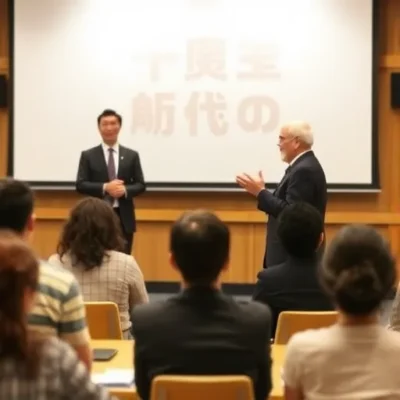The world of hypnosis has long been shrouded in mystery and misconception, but for Hypnosis Creator Tamura, it is a realm of profound healing and personal transformation. On March 20th, Tamura held an advanced-level Nonverbal Hypnosis seminar in Osaka, Japan, where he shared his expertise and guided participants on a journey of self-discovery.
Hypnotherapy, the therapeutic application of hypnosis, has gained increasing recognition in recent years as a powerful tool for addressing a wide range of physical and psychological issues. Tamura’s approach, known as Nonverbal Hypnosis, delves even deeper, focusing on the intricate language of the body and the subtle connections between the conscious and subconscious mind.

 Audible Audiobook – Unabridged
Audible Audiobook – UnabridgedOne of the seminar participants shared their feedback, expressing the profound impact the experience had on them. “The content you taught us was so rich and extensive that it’s difficult to convey it all to others,” the participant wrote. “For me, the most valuable lesson was understanding the importance of attunement (brain-to-brain connection). From tomorrow, I will start applying what I’ve learned in my clinical practice.”
This sentiment echoes the very essence of Tamura’s work: to empower individuals with the tools and knowledge to enhance their personal and professional lives. By mastering the art of Nonverbal Hypnosis, participants can tap into the inherent power of the mind-body connection, fostering deeper connections, greater self-awareness, and a renewed sense of purpose.
Unlocking the Power of Nonverbal Hypnosis: A Transformative Journey
The world of hypnosis has long captivated the human imagination, with its ability to unlock the subconscious and facilitate profound personal growth. Today, we explore the transformative power of nonverbal hypnosis, a technique that promises to revolutionize the way we approach personal development and clinical practice.
Nonverbal Hypnosis: A Silent Symphony of the Mind

Hypnosis creator Tamura’s recent lecture on nonverbal hypnosis in Osaka was a testament to the sheer potential of this remarkable technique. By harnessing the power of nonverbal communication, Tamura guided his students through a masterclass in the art of hypnotherapy, seamlessly blending theory and practical applications. The participants, eager to harness this newfound knowledge, left the session with a renewed sense of purpose and confidence, ready to apply these transformative principles in their respective fields.
The essence of nonverbal hypnosis lies in its ability to establish a profound connection between the practitioner and the subject, without the need for verbal cues. Through subtle gestures, body language, and a deep understanding of the subconscious mind, Hypnosis creator Tamura demonstrated how to create a state of heightened awareness and suggestibility, paving the way for remarkable breakthroughs. As one participant eloquently expressed, “The importance of achieving brain-to-brain synchronization was a revelation to me. I can’t wait to apply these principles in my clinical practice, starting tomorrow.”
The resonance of Hypnosis creator Tamura’s teachings extends far beyond the confines of the classroom. His approach to nonverbal hypnosis has the power to transcend traditional boundaries, touching the lives of individuals across diverse professions and personal backgrounds. Whether one seeks to enhance their therapeutic practice, unlock their full potential, or simply embark on a journey of self-discovery, the lessons imparted during this seminar offer a roadmap to a more harmonious and fulfilling existence. As the participants attested, “This is not just about learning a new technique; it’s about discovering the true essence of what it means to connect, empower, and transform.”

In the ever-evolving landscape of therapeutic interventions, nonverbal hypnosis emerges as a profound and intricate modality that transcends traditional communication barriers. The recent advanced hypnosis workshop in Osaka, led by Hypnosis Creator Tamura, illuminated the nuanced depths of interpersonal connection and neurological synchronization. Participants delved into sophisticated techniques that explore the intricate dance between conscious and unconscious communication, revealing how subtle, non-linguistic cues can profoundly influence human perception and healing processes. This immersive learning experience highlighted the critical importance of understanding the unspoken language of human interaction, demonstrating that true therapeutic intervention extends far beyond verbal exchange.
The workshop’s participants were guided through complex methodologies that emphasized the significance of brain-to-brain synchronization, a concept that fundamentally challenges traditional therapeutic paradigms. By mastering nonverbal hypnosis techniques, practitioners gain a transformative toolkit that enables deeper, more intuitive connections with their clients. The feedback received from participants underscored the workshop’s profound impact, with many expressing a renewed sense of professional purpose and therapeutic potential. One participant’s reflective commentary captured the essence of the learning experience: “The course provided a comprehensive understanding of therapeutic synchronization, empowering me to approach my professional practice with increased confidence and depth.”
The broader implications of advanced hypnotherapy extend well beyond individual therapeutic sessions, representing a paradigm shift in understanding human communication and healing processes. By recognizing the intricate neural pathways and nonverbal communication channels, practitioners can develop more holistic and nuanced approaches to supporting individual transformation. The workshop led by Hypnosis Creator Tamura not only equipped participants with advanced technical skills but also invited them to explore the deeper philosophical and psychological dimensions of human interaction. This comprehensive approach encourages practitioners to view their work as a sacred art of facilitating personal growth, where technical expertise meets profound empathetic understanding, ultimately creating a more integrated and compassionate approach to healing.




Comments